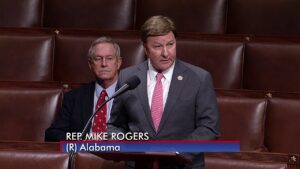The new leader of the House Armed Services Committee on Thursday said he’s planning for a “very aggressive schedule” of briefings and hearings with an aim to markup the next version of the National Defense Authorization Act (NDAA) this spring.
Rep. Mike Rogers (R-Ala.), the new HASC chair, said a focus of the FY ‘24 NDAA will be finding cost savings at the Pentagon, to include examining cuts to capabilities that may not be required for future threats.

“As we build the FY ‘24 NDAA, we will be laser-focused on the threats we face and the capabilities we need to defeat them. We will closely examine programs to determine if they actually provide the capabilities that we need to defeat threats we face. If they don’t, they will be cut,” Rogers said during opening remarks at HASC’s organizational meeting. “At the end of the day, I expect we will find a lot of savings at the Pentagon. But I want to be clear about this, modernizing our military will cost a lot of money. And we cannot shy away from that investment.”
Rogers’ comments that continued military modernization efforts “will cost a lot of money” comes as House Republican leaders have downplayed the potential for billions of dollars in defense spending cuts as part of a reported plan detailed during a closed-door GOP Conference meeting to limit discretionary spending in FY ‘24 at FY ‘22 enacted levels (Defense Daily, Jan. 10).
A group of moderate Democrats sent a letter to House Speaker Kevin McCarthy last month urging him to reconsider pursuing such a proposal, which they said could lead to a $75 billion cut to the defense budget (Defense Daily, Jan. 13).
Rogers also said HASC will hold its first hearings of the new Congress next week, one next Tuesday examining threats from China and “how to best prepare our military to deter and defeat them” and another on Wednesday focused on the state of the defense industrial base “and the work we need to do to ensure that they are prepared for future conflicts.”
“I expect we will continue to have a very aggressive schedule of hearings and briefings that will lead up to the [NDAA] mark later this spring. Oversight is going to be very important to Congress. At both the full committee and subcommittee level, we will be closely examining decisions made by this administration. We will demand to know how these decisions impact our ability to build the ready, lethal and capable fighting force that we need to deter China and our other adversaries,” Rogers said on Thursday.
Last year’s HASC markup of the FY ‘23 NDAA was in June and included more than 16 hours of debate on a series of amendments, with the full House then taking up the bill in July.
Rogers last weeks announced HASC’s full slate of subcommittee leaders, to include Rep. Rob Wittman (R-Va.) for chair of the Tactical Air and Land Forces Subcommittee, Rep. Trent Kelly (R-Miss.) for the Seapower and Projection Forces Subcommittee, Rep. Doug Lamborn (R-Colo.) for the Strategic Forces Subcommittee, Rep. Mike Gallagher (R-Wis.) for the Subcommittee on Cyber, Innovative Technologies, and Information Systems, Rep. Jack Bergman (R-Mich.) for the Subcommittee on Intelligence and Special Operations, Rep. Jim Banks (R-Ind.) for the Military Personnel Subcommittee and Rep. Michael Waltz (R-Fla.) for the Readiness Subcommittee (Defense Daily, Jan. 25).